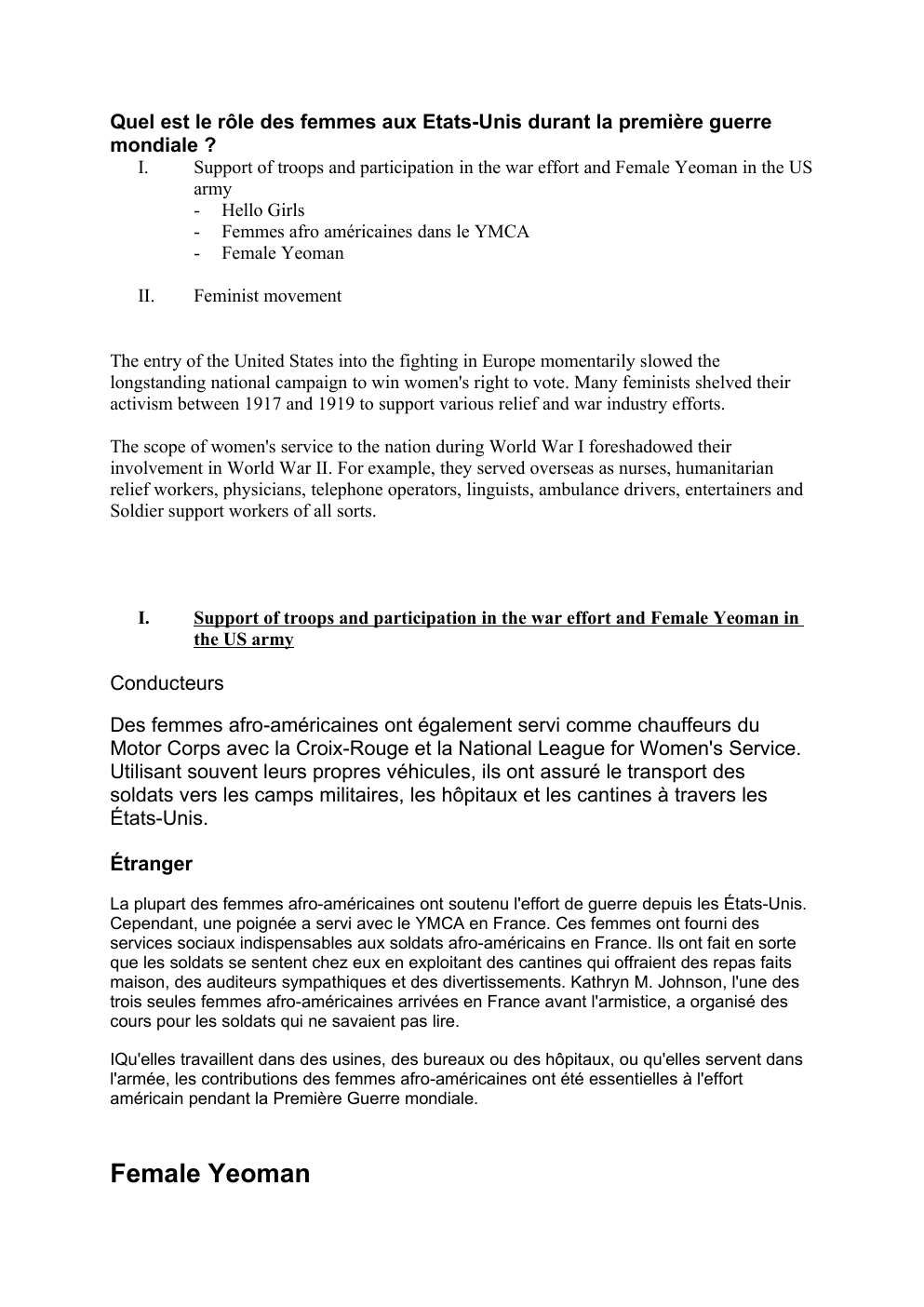Quel est le rôle des femmes aux Etats UNis
Publié le 22/06/2025
Extrait du document
«
Quel est le rôle des femmes aux Etats-Unis durant la première guerre
mondiale ?
I.
Support of troops and participation in the war effort and Female Yeoman in the US
army
- Hello Girls
- Femmes afro américaines dans le YMCA
- Female Yeoman
II.
Feminist movement
The entry of the United States into the fighting in Europe momentarily slowed the
longstanding national campaign to win women's right to vote.
Many feminists shelved their
activism between 1917 and 1919 to support various relief and war industry efforts.
The scope of women's service to the nation during World War I foreshadowed their
involvement in World War II.
For example, they served overseas as nurses, humanitarian
relief workers, physicians, telephone operators, linguists, ambulance drivers, entertainers and
Soldier support workers of all sorts.
I.
Support of troops and participation in the war effort and Female Yeoman in
the US army
Conducteurs
Des femmes afro-américaines ont également servi comme chauffeurs du
Motor Corps avec la Croix-Rouge et la National League for Women's Service.
Utilisant souvent leurs propres véhicules, ils ont assuré le transport des
soldats vers les camps militaires, les hôpitaux et les cantines à travers les
États-Unis.
Étranger
La plupart des femmes afro-américaines ont soutenu l'effort de guerre depuis les États-Unis.
Cependant, une poignée a servi avec le YMCA en France.
Ces femmes ont fourni des
services sociaux indispensables aux soldats afro-américains en France.
Ils ont fait en sorte
que les soldats se sentent chez eux en exploitant des cantines qui offraient des repas faits
maison, des auditeurs sympathiques et des divertissements.
Kathryn M.
Johnson, l'une des
trois seules femmes afro-américaines arrivées en France avant l'armistice, a organisé des
cours pour les soldats qui ne savaient pas lire.
IQu'elles travaillent dans des usines, des bureaux ou des hôpitaux, ou qu'elles servent dans
l'armée, les contributions des femmes afro-américaines ont été essentielles à l'effort
américain pendant la Première Guerre mondiale.
Female Yeoman
Despite thousands of new recruits, the U.S.
Navy was short-handed at the beginning of
World War I.
Vague wording in a section of the Naval Act of 1916 outlining who could serve
created a loophole: women were able to join the ranks as Yeomen, non-commissioned
officers.
Around 12,000 women enlisted in the Navy under the title, “Yeoman (F).”
Most women Yeomen served stateside on naval bases, replacing men who had deployed to
Europe.
While many female recruits performed clerical duties, some worked as truck drivers,
mechanics, radio operators, telephone operators, translators, camouflage artists and
munition workers.
They had the same responsibilities as their male counterparts and
received the same pay of $28.75 per month
The “Hello Girls”
Aiming to improve communications on the Western front between the Allied Forces, General
John J.
Pershing called for the creation of the Signal Corps Female Telephone Operators
Unit.
The unit recruited women who were bilingual in French and English to serve as
telephone switchboard operators on the Western front.
The women received physical
training, observed strict military protocol, wore identity discs and worked very close to the
front lines.
These female recruits were nicknamed the “Hello Girls” (a term which some of
them felt disparaged their efforts) and became known for their bravery and focus under
pressure.
However, upon their return to the United States after the end of the war, the “Hello
Girls” did not receive veteran status or benefits.
It wasn’t until 1977, when President Jimmy
Carter signed legislation, that the few surviving women telephone operators received
recognition of their veteran status.
The First World War is often described as the first “modern” war.
The term generally refers to
mechanized warfare in the form of tanks and airplanes; terrorizing civilian populations as an
act of war; and the mobilization of society as a whole.
But it could also apply to the new roles
of women in their nations’ war efforts.
Increasing manpower demands on the part of all the combatant powers in World War I made
it easier for women to make official contributions, though few would fight.
Women signed up
as ambulance drivers, telephone operators, munitions workers, members of various service
auxiliaries and even as soldiers in Bolshevik Russia’s all-female units.
In the United States,
the Navy’s “yeomanettes” and the Army’s Hello Girls were the first American women to
openly serve in (or at least with) the military.
And, though they served in the same war for the
same nation, their experiences differed greatly.
III.
Les femmes infirmières
Infirmières
La Croix-Rouge américaine a résisté à l'activation des quelque 1,800 1918 infirmières afroaméricaines certifiées pour le service militaire jusqu'à la fin de la guerre, lorsque la pandémie
de 18 a créé une pénurie d'infirmières.....
»
↓↓↓ APERÇU DU DOCUMENT ↓↓↓
Liens utiles
- Etats-Unis-Brésil: rôle mondial, dynamiques territoriales
- Etats-Unis et Brésil : rôle mondial et dynamiques des territoires
- exposé sur la religion aux etats unis
- HGGSP: Comment l'environnement s’est construit comme un problème public au Etats Unis ?
- La migration de populations hipaniques aux Etats Unis


